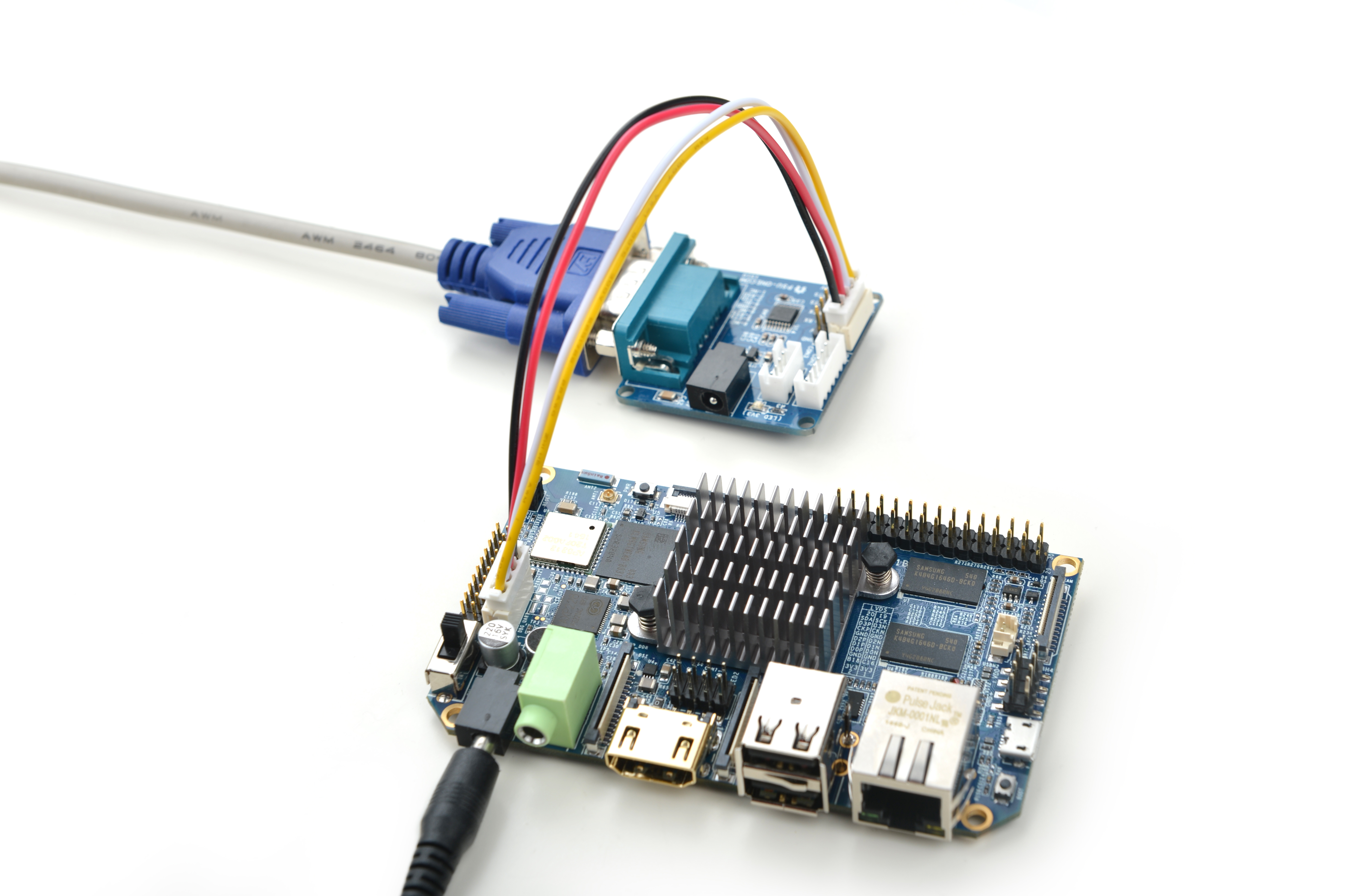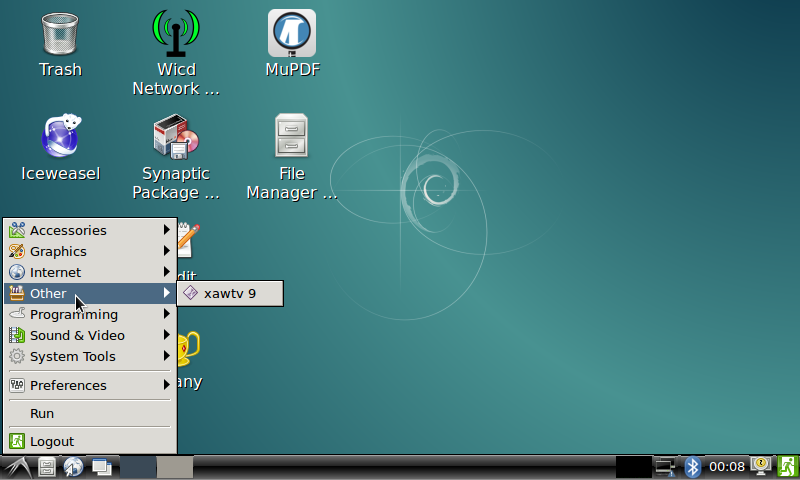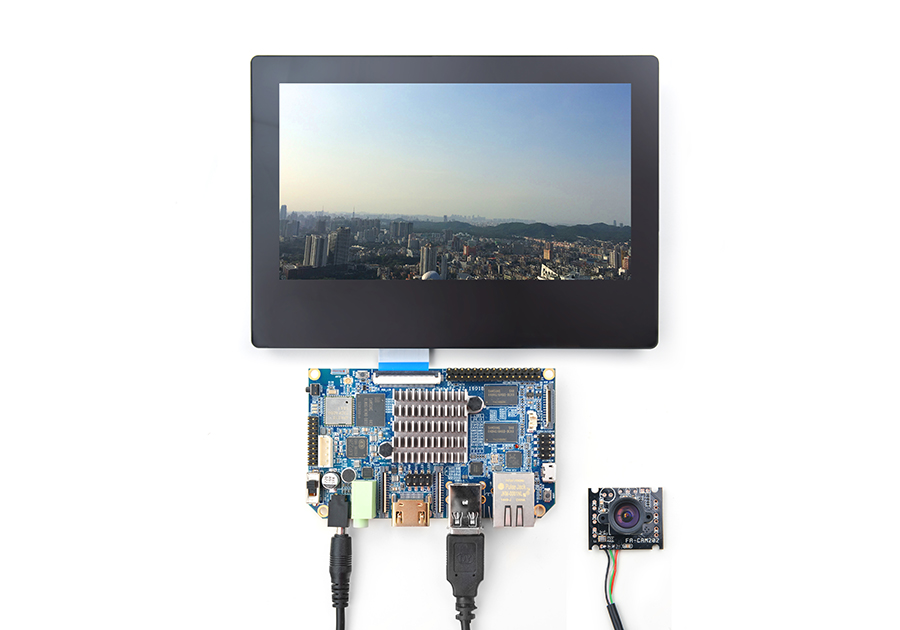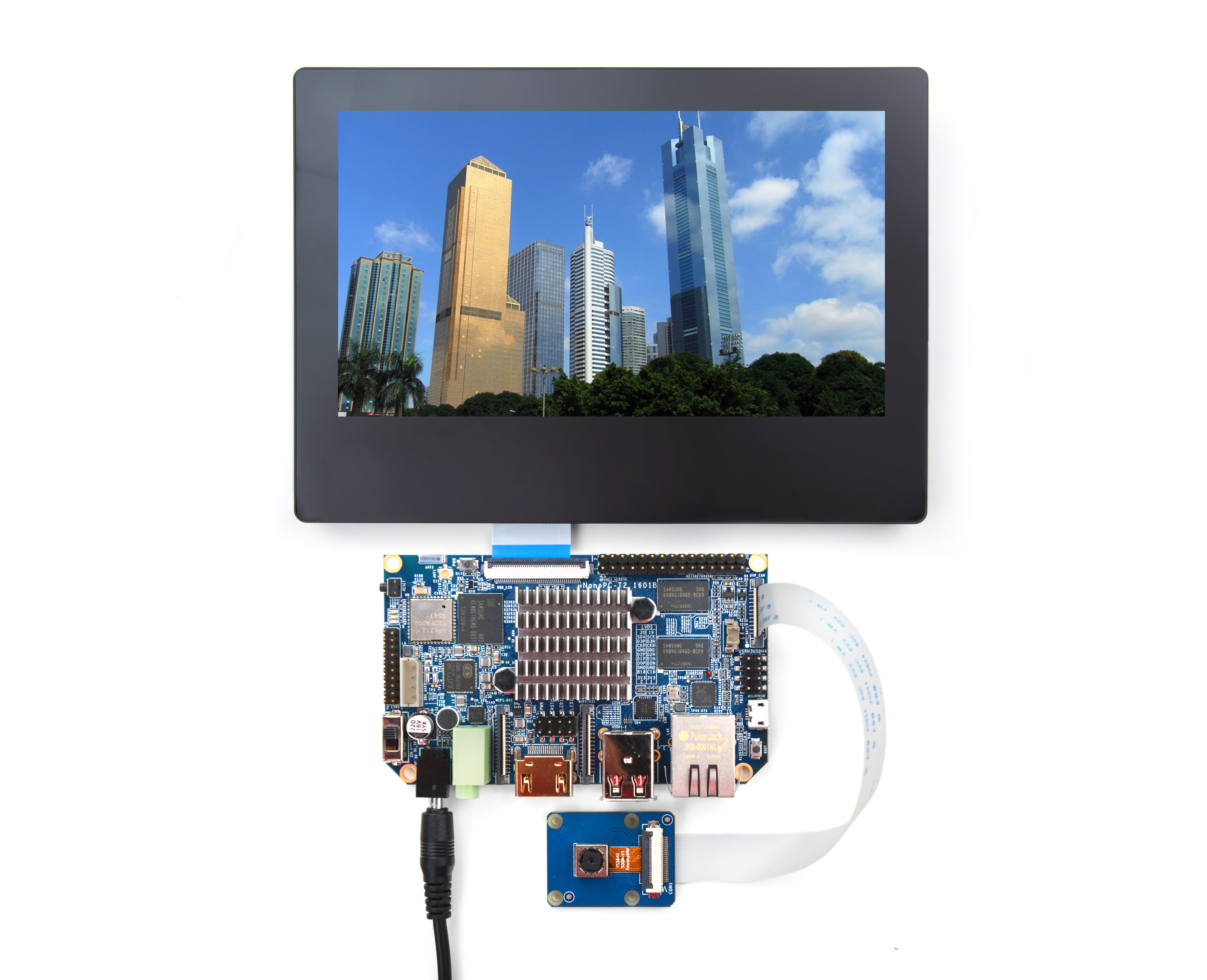Template:S5P4418Software
Contents
- 1 Get Started
- 1.1 Essentials You Need
- 1.2 Boot from SD Card
- 1.3 Flash image to eMMC with eflasher
- 1.4 Make Installation Card under Linux Desktop
- 1.5 Extend NanoPC-T2's SD Card Section
- 1.6 LCD/HDMI Resolution
- 1.7 Update Image Files in SD Card From PC Host
- 1.8 Run Android or Debian
- 1.9 Login to Debian via VNC or SSH
- 2 Working with Debian
- 3 Ubuntu-Core with Qt-Embedded
- 4 Make Your Own OS Image
- 5 Connect NanoPC-T2 to External Modules
- 6 Access Hardware under Android
- 7 More OS Support
- 8 Source Code and Image Files Download Links
- 9 Resources
- 10 Tech Support
1 Get Started
1.1 Essentials You Need
Before starting to use your NanoPC-T2 get the following items ready
- NanoPC-T2
- SD Card: Class 10 or Above, minimum 8GB SDHC
- A DC 5V/2A power is a must
- HDMI monitor or LCD
- USB keyboard, mouse and possible a USB hub(or a TTL to serial board)
- A host computer running Ubuntu 14.04 64 bit system
1.2 Boot from SD Card
Get the following files from here download link:
- Get a 8G SDHC card and backup its data if necessary.
| Image Files | |
| s5p4418-sd-friendlycore-xenial-4.4-armhf-YYYYMMDD.img.zip | FriendlyCore with Qt 5.10.0 (base on Ubuntu core) image file |
| s5p4418-sd-lubuntu-desktop-xenial-4.4-armhf-YYYYMMDD.img.zip | LUbuntu Desktop image file with X Window |
| s5p4418-sd-friendlywrt-4.4-YYYYMMDD.img.zip | FriendlyWrt image file (base on OpenWrt) |
| s5p4418-sd-android7-YYYYMMDD.img.zip | Android7 image file |
| s5p4418-sd-android-kitkat-YYYYMMDD.img.zip | Android4.4 image file with support for 4G LTE |
| s5p4418-sd-android-lollipop-YYYYMMDD.img.zip | Android5.1 image file |
| s5p4418-eflasher-lubuntu-desktop-xenial-4.4-armhf-YYYYMMDD.img.zip | SD card image, which is used to install a lubuntu desktop to eMMC |
| s5p4418-eflasher-friendlywrt-4.4-YYYYMMDD.img.zip | SD card image, which is used to install a FriendlyWrt to eMMC |
| s5p4418-eflasher-android7-YYYYMMDD.img.zip | SD card image, which is used to install a android7 to eMMC |
| s5p4418-eflasher-friendlycore-xenial-4.4-armhf-YYYYMMDD.img.zip | SD card image, which is used to install a friendly-core to eMMC |
| s5p4418-eflasher-android-kitkat-YYYYMMDD.img.zip | SD card image, which is used to install a android4 to eMMC |
| s5p4418-eflasher-android-lollipop-YYYYMMDD.img.zip | SD card image, which is used to install a android5 to eMMC |
| Flash Utility: | |
| win32diskimager.rar | Windows utility. Under Linux users can use "dd" |
- Uncompress these files. Insert an SD card(at least 4G) into a Windows PC and run the win32diskimager utility as administrator. On the utility's main window select your SD card's drive, the wanted image file and click on "write" to start flashing the SD card.
- Insert this card into your board's boot slot, press and hold the boot key (only applies to a board with onboard eMMC) and power on (with a 5V/2A power source). If the PWR LED is on and LED1 is blinking this indicates your board has successfully booted.
1.3 Flash image to eMMC with eflasher
- Download eflasher
Get the eflasher utility s5p4418-eflasher-sd8g-xxx-full.img.7z
This package includes a Ubuntu Core, Debian, Android 5 and Android 4.4 image files;
Get the Windows utility: win32diskimager.rar;
- Flash eflasher Image
Extract the .7z package and you will get .img files.Insert an SD card(at least 4G) into a Windows PC and run the win32diskimager utility as administrator. On the utility's main window select your SD card's drive, the wanted image file and click on "write" to start flashing the SD card.
If your PC runs Linux you can use the dd command to flash a .img file to the SD card;
- Flash image to eMMC
Insert this card into your NanoPC-T2, connect the board to an HDMI monitor or an LCD, press and hold the boot key and power on (with a 5V/2A power source) the board. After your board is powered on you will see multiple OS options and you can select an OS to start installation.
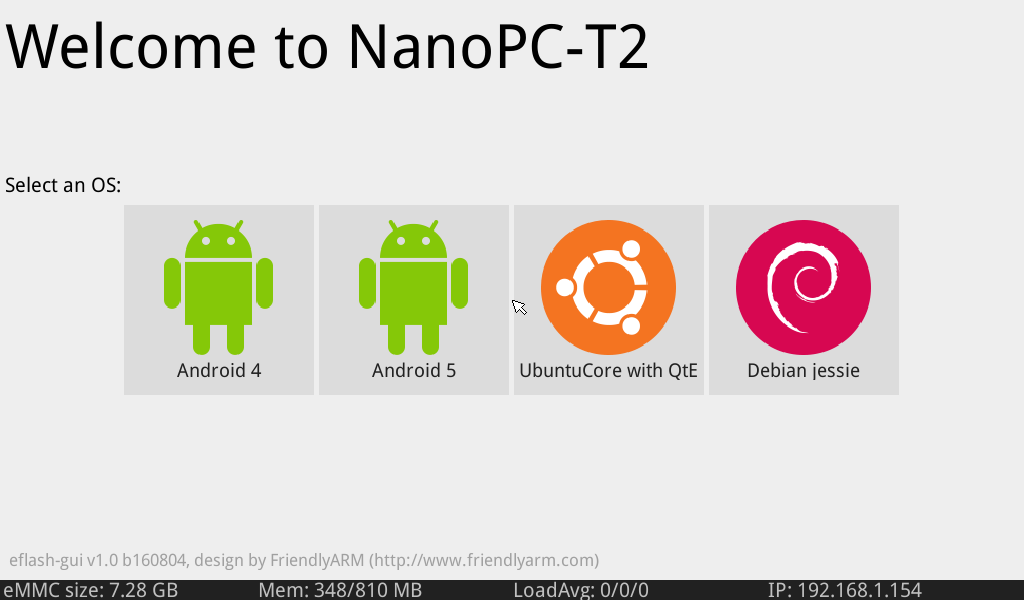
1.4 Make Installation Card under Linux Desktop
- 1) Insert your SD card into a host computer running Ubuntu and check your SD card's device name
dmesg | tail
Search the messages output by "dmesg" for similar words like "sdc: sdc1 sdc2". If you can find them it means your SD card has been recognized as "/dev/sdc". Or you can check that by commanding "cat /proc/partitions"
- 2) Downlaod Linux script
git clone https://github.com/friendlyarm/sd-fuse_nanopi2.git cd sd-fuse_nanopi2
- 3) Make Android SD Card
su ./fusing.sh /dev/sdx
(Note: you need to replace "/dev/sdx" with the device name in your system)
When you run the script for the first time it will prompt you to download an image you have to hit “Y” within 10 seconds otherwise you will miss the download
- 4) Here is how to make a Debian SD card
./fusing.sh /dev/sdx debian
1.5 Extend NanoPC-T2's SD Card Section
- When Debian/Ubuntu is loaded the SD card's section will be automatically extended.
- When Android is loaded you need to run the following commands on your host PC to extend your SD card's section:
sudo umount /dev/sdx? sudo parted /dev/sdx unit % resizepart 4 100 resizepart 7 100 unit MB print sudo resize2fs -f /dev/sdx7
(Note: you need to replace "/dev/sdx" with the device name in your system)
1.6 LCD/HDMI Resolution
When the system boots our uboot will check whether it is connected to an LCD or to an HDMI monitor. If it recognizes an LCD it will configure its resolution. Our uboot defaults to the HDMI 720P configuration.
If you want to modify the LCD resolution you can modify file "arch/arm/plat-s5p4418/nanopi2/lcds.c" in the kernel and recompile it.
If your NanoPC-T2 is connected to an HDMI monitor and it runs Android it will automatically set the resolution to an appropriate HDMI mode by checking the "EDID". If your NanoPC-T2 is connected to an HDMI monitor and it runs Debian by default it will set the resolution to the HDMI 720P configuration. If you want to modify the HDMI resolution to 1080P modify your kernel's configuration as explained above.
1.7 Update Image Files in SD Card From PC Host
If you want to make some changes to the image files in your SD card follow the steps below otherwise you can skip this section.
Insert your SD card into a host PC running Linux, mount the boot and rootfs sections of the SD card and follow the steps below:
1) If you want to change your kernel command line parameters you can do it via the fw_setevn utility under "sd-fuse_nanopi2/tools".
Check the current Command Line:
cd sd-fuse_nanopi2/tools ./fw_printenv /dev/sdc | grep bootargs
Android 5.1.1_r6 starts SELinux. By default it is enforcing. You can change it this way:
./fw_setenv /dev/sdc bootargs XXX androidboot.selinux=permissive
This sets it to "permissive". The "XXX" stands for the original bootargs' value.
2) Update Kernel
Our customized uboot will check the LCD type when it boots.
For a non-Android OS if it recognizes that an LCD is connected to the NanoPC-T2 it will load "uImage" from "boot" otherwise it will load "uImage.hdmi".
For Android it doesn't make any difference which display device is detected. You can use your generated uImage to replace the existing one under "boot".
For Debian if your generated kernel is for an LCD you need to replace the existing uImage or if your kernel is for an HDMI monitor you need to replace the existing uImage.hdmi.
1.8 Run Android or Debian
- Insert an SD card with Android/Debian image file into your NanoPC-T2, connect the board to an HDMI monitor, press and hold the boot key, power on the board the NanoPC-T2 will boot from the SD card. If you can see the PWR LED on and the LED1 flashing it means your board is working and you will see Android/Debain being loaded on the HDMI monitor.
1)If you connect the NanoPC-T2 to an HDMI monitor you need to use a USB mouse and a USB keyboard to operate. If you connect it to an LCD with capacitive touch you can operate directly on the LCD.
2)If you want to do kernel development you need to use a serial communication board, ie a PSU-ONECOM board, which will allow you to operate the board via a serial terminal.
- Here is a setup where we connect a NanoPC-T2 to a PC running Ubuntu and Minicom via a serial cable you will see system messages output to the PC’s minicom terminal:
- Under Debian the password for "root" is "fa"
1.9 Login to Debian via VNC or SSH
If your NanoPC-T2 is not connected to a display device and your board runs the "-wifiap.img" image you can login to your NanoPC-T2's nanopi2-wifiap(the default password is "123456789") via a mobile phone. You can download and install a "VNC Viewer" from here on a mobile phone and login to the NanoPC-T2 via VNC. Its default password is "fa123456".
Here is a screenshot which shows how it looks like when users login to the NanoPC-T2 from an iPhone via VNC:
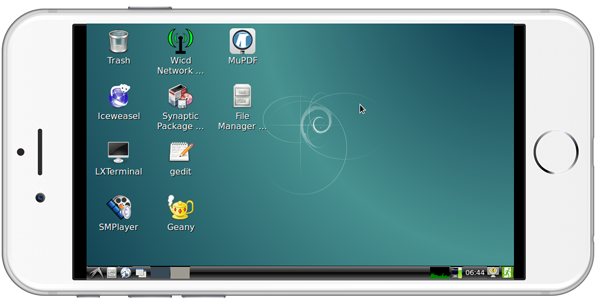
You can login via "SSH -l root 192.168.8.1" the default password for "root" is "fa"
To make SSH session run faster turn off the WiFi's power saving mode by using the following command:
iwconfig wlan0 power off
2 Working with Debian
2.1 Ethernet Connection
- If the NanoPC-T2 is connected to a network via Ethernet before it is powered on, it will automatically obtain an IP after it is powered up.
2.2 Wireless Connection
Under Debian you can manage your network with NetworkManager.
After Debian boots click on the network icon on the bottom right of the task bar a NetworkManger menu will pop up and all the available networks will be listed. If there is an active wireless network you will see something similar to the following screenshot:
![]()
You can click on a WiFI AP and connect your board to it.
For more details refer to:NetworkManager.
2.3 Setup Wi-Fi AP
Follow the steps below. Since our OS image by default already has the NetworkManager utility you will be prompted to uninstall it first:
sudo turn-wifi-into-apmode yes
After you uninstall the NetworkManager reboot your board.
After your board is rebooted run the above commands again and you will be prompted to type in a WIFI's name and password. Type in your wanted name and password
If this is successful you will be able to find and connect your board to a WIFI. Login to your board at 192.168.8.1:
ssh root@192.168.8.1
Type in a password. In our system the password is "fa".
To login smoothly via SSH we recommend you turning off WIFI's power save mode by running the following commands:
sudo iwconfig wlan0 power offYou can check your WiFi's mode by running the following command:
sudo cat /sys/module/bcmdhd/parameters/op_mode
Number 2 means your WiFi is in AP mode. You can switch to the Station mode by running the following command:
sudo turn-wifi-into-apmode no2.4 Bluetooth
Here are the steps to transfer a file from T2 to a mobile phone. Run the following command to search a surrounding Bluetooth device:
hcitool scan
In our example a mobile phone was detected and the following messages were listed:
Scanning ...
38:BC:1A:B1:7E:DD MEIZU MX4
These messages indicated that a MEIZU MX4 mobile phone was detected. We then checked the Bluetooth services this phone supported with its MAC address presented in front of its device name
sdptool browse 38:BC:1A:B1:7E:DDNote: you need to use your device's name and its MAC address when you run these commands.
The command listed all the services the phone supported. We needed the "OBEX Object Push" service which is for file transfers.
Service Name: OBEX Object Push
Service RecHandle: 0x1000b
Service Class ID List:
"OBEX Object Push" (0x1105)
Protocol Descriptor List:
"L2CAP" (0x0100)
"RFCOMM" (0x0003)
Channel: 25
"OBEX" (0x0008)
Profile Descriptor List:
"OBEX Object Push" (0x1105)
Version: 0x0100
From the above messages we could get the channel number 25 for the "OBEX Object Push" service. We input this number to the "ussp-push" by running the following command:
ussp-push 38:BC:1A:B1:7E:DD@25 example.jpg example.jpg
Note: you need to use your device's name, its MAC address and channel number when you run these commands.
Usually after the above commands are run a popup window will show on the phone that communicates with T2 and you can start file transfers.
Common Issues:
1) If T2 cannot find a Bluetooth device you can try this command to restart its Bluetooth:
rfkill unblock 02) If any of these commands is not installed you can try this command to install it:
apt-get install bluetooth bluez obexftp openobex-apps python-gobject ussp-push2.5 Install Debian Packages
We provide a Debian Jessie image. You can install Jessie's packages by commanding "apt-get". If this is your first installation you need to update the package list by running the following command
apt-get updateYou can install your preferred packages. For example if you want to install an FTP server you can do this:
apt-get install vsftpdNote: you can change your download server by editting "/etc/apt/sources.list". You can get a complete server list from [1]. You need to select the one with "armhf".
2.6 Audio Output from HDMI or 3.5mm Jack under Debian
Our default Debian image for the NanoPC-T2 doesn't support audio output. If you want to enable this function you need to install the alsa package.
- Make sure your Debian OS is our latest version and your board has access to the internet;
- Power up your board and run the following commands on your board's commandline utility to install the alsa package:
apt-get update apt-get install libasound2 apt-get install alsa-base apt-get install alsa-utils
- After the installation is done copy a ".wav" audio file to your NanoPC-T2, connect your T2 to a earphone or speaker and try playing this audio file(By default Debian's audio output is from the 3.5mm audio jack):
aplay music.wav- By default Debian's audio output is from the 3.5mm audio jack. If you want audio output from the HDMI you need to change the setting by editing the "/etc/asound.conf" file:
pcm.!default { type hw card 1 device 0} ctl.!default { type hw card 1}
card 0 stands for the 3.5mm audio jack and card 1 stands for the HDMI audio. After you make your change reboot your board to make it effective.
3 Ubuntu-Core with Qt-Embedded
3.1 Introduction
Ubuntu Core with Qt-Embedded is a light Linux system without X-windows. It uses the Qt-Embedded's GUI and is popular in industrial and enterprise applications.
Besides the regular Ubuntu core's features our Ubuntu-Core has the following additional features:
- it supports our LCDs with both capacitive touch and resistive touch(S700, X710, S70)
- it supports WiFi
- it supports Ethernet
- it supports Bluetooth and has been installed with bluez utilities
- it supports audio playing
For more details refer to Ubuntu Core with Qt-Embedded.
4 Make Your Own OS Image
4.1 Install Cross Compiler
Download the compiler package:
git clone https://github.com/friendlyarm/prebuilts.git sudo mkdir -p /opt/FriendlyARM/toolchain sudo tar xf prebuilts/gcc-x64/arm-cortexa9-linux-gnueabihf-4.9.3.tar.xz -C /opt/FriendlyARM/toolchain/
Then add the compiler's directory to "PATH" by appending the following lines in "~/.bashrc":
export PATH=/opt/FriendlyARM/toolchain/4.9.3/bin:$PATH export GCC_COLORS=auto
Execute "~/.bashrc" to make the changes take effect. Note that there is a space after the first ".":
. ~/.bashrcThis compiler is a 64-bit one therefore it cannot be run on a 32-bit Linux machine. After the compiler is installed you can verify it by running the following commands:
arm-linux-gcc -v Using built-in specs. COLLECT_GCC=arm-linux-gcc COLLECT_LTO_WRAPPER=/opt/FriendlyARM/toolchain/4.9.3/libexec/gcc/arm-cortexa9-linux-gnueabihf/4.9.3/lto-wrapper Target: arm-cortexa9-linux-gnueabihf Configured with: /work/toolchain/build/src/gcc-4.9.3/configure --build=x86_64-build_pc-linux-gnu --host=x86_64-build_pc-linux-gnu --target=arm-cortexa9-linux-gnueabihf --prefix=/opt/FriendlyARM/toolchain/4.9.3 --with-sysroot=/opt/FriendlyARM/toolchain/4.9.3/arm-cortexa9-linux-gnueabihf/sys-root --enable-languages=c,c++ --with-arch=armv7-a --with-tune=cortex-a9 --with-fpu=vfpv3 --with-float=hard ... Thread model: posix gcc version 4.9.3 (ctng-1.21.0-229g-FA)
4.2 Compile U-Boot
Download the U-Boot source code and compile it. Note that the github's branch is nanopi2-lollipop-mr1:
git clone https://github.com/friendlyarm/uboot_nanopi2.git cd uboot_nanopi2 git checkout nanopi2-lollipop-mr1 make s5p4418_nanopi2_config make CROSS_COMPILE=arm-linux-
After your compilation succeeds a u-boot.bin will be generated. If you want to test it flash it to your installation SD card via fastboot. Here is how you can do it:
1) On your host PC run "sudo apt-get install android-tools-fastboot" to install the fastboot utility;
2) Connect your NanoPC-T2 to your host PC via a serial cable (e.g. PSU-ONECOME). Press the enter key within two seconds right after you power on your NanoPC-T2 and you will enter uboot's command line mode;
3) After type in "fastboot" and press "enter" you will enter the fastboot mode;
4) Connect your NanoPC-T2 to this host PC via a microUSB cable and type in the following command to flash u-boot.bin:
fastboot flash bootloader u-boot.bin
Warning: you cannot update this SD card by commanding "dd". This command will cause trouble when booting the NanoPC-T2.
4.3 Prepare mkimage
You need the mkimage utility to compile a U-Boot source code package. Make sure this utility works well on your host before you start compiling a uImage.
You can install this utility by either commanding "sudo apt-get install u-boot-tools" or following the commands below:
cd uboot_nanopi2 make CROSS_COMPILE=arm-linux- tools sudo mkdir -p /usr/local/sbin && sudo cp -v tools/mkimage /usr/local/sbin
4.4 Compile Linux Kernel
4.4.1 Compile Kernel
- Download Kernel Source Code
git clone https://github.com/friendlyarm/linux-3.4.y.git cd linux-3.4.y git checkout nanopi2-lollipop-mr1
The NanoPC-T2's kernel source code lies in the "nanopi2-lollipop-mr1" branch.
- Compile Android Kernel
make nanopi2_android_defconfig touch .scmversion make uImage
- Compile Debian Kernel
make nanopi2_linux_defconfig touch .scmversion make uImage
After your compilation succeeds a uImage will be generated in the "arch/arm/boot/uImage" directory. This kernel is for LCD output. You can use it to replace the existing uImage.
If you want to generate a kernel for HDMI output you need to run nanopi2_linux_hdmi_defconfig and do it this way:
make nanopi2_linux_hdmi_defconfig touch .scmversion make menuconfig
After your compilation succeeds a uImage will be generated for HDMI 720P. If you want a uImage for 1080P you can do it this way:
touch .scmversion make nanopi2_linux_hdmi_defconfig make menuconfig Device Drivers --> Graphics support --> Nexell Graphics --> [ ] LCD [*] HDMI (0) Display In [0=Display 0, 1=Display 1] Resolution (1920 * 1080p) ---> make uImage
After your compilation succeeds a uImage will be generated for HDMI 1080P. You can use it to replace the existing uImage.hdmi.
- Compile Kernel for Ubuntu Core
The steps here are nearly the same as the steps for compiling a Debian kernel:
LCD Output:
make nanopi2_core-qt_defconfigHDMI Output:
make nanopi2_core-qt_hdmi_defconfigSelect your configuration file and run the following commands to generate a uImage.
touch .scmversion make uImage
4.4.2 User Your Generated Kernel
- Update the kernel file in SD card
If you use an SD card to boot Android you can copy your generated uImage file to your SD card's boot section(e.g. section 1 /dev/sdX1).
If you use an SD card to Debian and you generated a uImage for an HDMI monitor you can use that uImage to replace the uImage.hdmi file in the SD card's boot section. If you use an SD card to Debian and you generated a uImage for an LCD you can use that uImage to replace the uImage file in the SD card's boot section.
- Update Android kernel file in eMMC
If you want to update the kernel file in eMMC you need firstly boot your board, then mount eMMC's boot section, replace the boot section's kernel file with your generated one and reboot your board to make your new kernel run.
If you boot your board from eMMC you can update your kernel file by following the steps below:
1) After Android is loaded mount eMMC's boot section (in our example eMMC's device name was /dev/mmcblk0p1) by using the following commands:
su mount -t ext4 /dev/block/mmcblk0p1 /mnt/media_rw/sdcard1/
2) Connect your board to a host PC running Ubuntu and copy the uImage file to eMMC's boot section by running the following commands
adb push uImage /mnt/media_rw/sdcard1/
3) Or you can copy your generated kernel file to an external storage card(e.g. an SD card or a USB drive), connect the storage card to your board the move the file from the card to eMMC's boot section
4) After update is done type in "reboot" to reload Android. Note don't directly power off and on the board or press the reset button to reboot the board. These two actions will damage your kernel file
- Update Debian kernel file in eMMC
If you boot your board from eMMC you can update your kernel file by following the steps below:
1) When Debian is being loaded eMMC's boot section will be automatically mounted(in our example eMMC's device name was /dev/mmcblk0p1). You can use "mount" to verify that
2) Connect your board to a host PC via Ethernet and copy your generated uImage file via scp/ftp to eMMC's boot section and replace the existing file. If your file is for an LCD use your uImage file to replace the existing uImage. If your file is for an HDMI monitor use your uImage.hdmi file to replace the existing uImage.hdmi file
3) Or you can copy your generated kernel file to an external storage card(e.g. an SD card or a USB drive), connect the storage card to your board the move the file from the card to eMMC's boot section
4) After update is done type in "reboot" to reload Debian. Note don't directly power off and on the board or press the reset button to reboot the board. These two actions will damage your kernel file
- Generate Your boot.img
If you want to generate an image file that can be flashed to eMMC you need to generate a boot.img file and copy it to your installation SD card
For Android copy the uImage file to Android source code's "device/friendly-arm/nanopi2/boot/" directory and compile this whole Android source code. After your compilation is successful you will get a boot.img file.
For Debian follow the steps below to generate a boot.img file
1) Download debian_nanopi2
git clone https://github.com/friendlyarm/debian_nanopi2.git
2) Copy the image file for an HDMI monitor and use it to replace the "debian_nanopi2/boot/uImage.hdmi" file and copy the image file for an LCD and use it to replace the "debian_nanopi2/boot/uImage" file
3) Generate Debian's boot.img
cd debian_nanopi2 mkdir rootfs ./build.sh
A newly generated boot.img will be under the "debian_nanopi2/sd-fuse_nanopi2/debian" directory.
The "mkdir rootfs" command creates a working directory for the build.sh script to run. It also creates some files such as "rootfs.img" but these files are useless.
4.4.3 Compile Kernel Modules
Android contains kernel modules which are in the "/lib/modules" directory in the system section. If you want to add your own modules to the kernel or you changed your kernel configurations you need to recompile these new modules.
Compile Original Kernel Modules:
cd linux-3.4.y make CROSS_COMPILE=arm-linux- modules
Here we have two new modules and we can compile them by following the commands below:
cd /opt/FriendlyARM/s5p4418/android ./vendor/friendly-arm/build/common/build-modules.sh
The "/opt/FriendlyARM/s5p4418/android" directory points to the top directory of Android source code. You can get more details by specifying option "-h".
After your compilation succeeds new modules will be generated
4.5 Compile Android
We provide two Android versions: Android 4.4 and Android 5.1. Both of them are compiled the same way.
- Install Cross Compiler
Install 64 bit Ubuntu 14.04 on your host PC.
sudo apt-get install bison g++-multilib git gperf libxml2-utils make python-networkx zip sudo apt-get install flex libncurses5-dev zlib1g-dev gawk minicom
For more details refer to https://source.android.com/source/initializing.html 。
- Download Android 5.1's Source Code
You need to use repo to get the Android source code. Refer to https://source.android.com/source/downloading.html 。
mkdir android && cd android repo init -u https://github.com/friendlyarm/android_manifest.git -b nanopi2-lollipop-mr1 repo sync
The "android" directory is the working directory.
If you want to try Android4.4's source code you can run the following commands:
mkdir android && cd android repo init -u https://github.com/friendlyarm/android_manifest.git -b nanopi2-kitkat repo sync
Option "-b" specifies a branch
- Compile System Package
source build/envsetup.sh lunch aosp_nanopi2-userdebug make -j8
After your compilation succeeds the following files will be generated in the "out/target/product/nanopi2/" directory.
filename partition Description boot.img boot - cache.img cache - userdata.img userdata - system.img system - partmap.txt - partition description file
- Flash Image to eMMC
After compiling Android successfully you can flash it to eMMC with either of the following methods
1) fastboot: right after the NanoPC-T2 is booted from eMMC press any key to enter the uboot commandline mode and type in "fastboot"
Connect your board to a host PC running Ubuntu with a USB cable and run the following commands in the PC's terminal:
cd out/target/product/nanopi2 sudo fastboot flash boot boot.img sudo fastboot flash cache cache.img sudo fastboot flash userdata userdata.img sudo fastboot flash system system.img sudo fastboot reboot
2) Use an SD Card
Copy these files: boot.img, cache.img, userdata.img, system.img, partmap.txt from the out/target/product/nanopi2 directory to your installation SD card's images/android directory and you can use this SD card to flash Android to eMMC
5 Connect NanoPC-T2 to External Modules
5.1 Connect NanoPC-T2 to USB Camera(FA-CAM202)
- In this use case the NanoPC-T 2 runs Debian. If you connect your NanoPC-T2 to our LCD or an HDMI monitor after Debain is fully loaded click on "other"-->"xawtv" on the left bottom of the GUI and the USB Camera application will be started. After enter "welcome to xawtv!" click on "OK" to start exploring.
5.2 Connect NanoPC-T2 to CMOS 5M-Pixel Camera
For more details about the CAM500A camera refer to [2]
- If your NanoPC-T2 runs Android5.1 and it is connected to our LCD or an HDMI monitor after Android is fully loaded click on the "Camera" icon and the application will be started. You can take pictures or record videos
- Under Debian/Ubuntu a camera utility "nanocams" is available for previewing 40 frames and picture taking. You can try it by following the commands below
sudo nanocams -p 1 -n 40 -c 4 -o IMG001.jpg
For more details about the usage of the nanocams run "nanocams -h". You can get its source code from our git hub:
git clone https://github.com/friendlyarm/nexell_linux_platform.git
5.3 Use OpenCV to Access USB Camera
- The full name of "OpenCV" is Open Source Computer Vision Library and it is a cross platform vision library.
- When the NanoPC-T2 runs Debian users can use OpenCV APIs to access a USB Camera device.
1. Here is a guideline on how to use OpenCV with C++ on the NanoPC-T2:
- Firstly you need to make sure your NanoPC-T2 is connected to the internet.Login to your NanoPC-T2 via a serial terminal or SSH. After login type in your username(root) and password(fa):
- Run the following commands:
apt-get update apt-get install libcv-dev libopencv-dev
2. Make sure your USB camera works with the NanoPC-T2. You can test your camera with NanoPC-T2's camera utility.
3. Check your camera device:
ls /dev/video*
- Note:in our test case video0 was the device name.
4. OpenCV's code sample(official code in C++) is under /home/fa/Documents/opencv-demo. Compile the code sample with the following commands:
cd /home/fa/Documents/opencv-demo make
After it is compiled successfully a "demo" executable will be generated
5. Connect NanoPC-T2 to USB Keyboard & Run the Following Command:
./demo5.4 Connect NanoPC-T2 to Matrix GPS Module
- The Matrix-GPS module is a small GPS module with high performance. It can be used in navigation devices, four-axle drones and etc.
- The Matrix-GPS module uses serial communication. When the NanoPC-T2 is connected to the Matrix GPS module, after the NanoPC-T2 is powered up type in the following command in a terminal or click on the xgps icon it will be started.
$su - fa -c "DISPLAY=:0 xgps 127.0.0.1:9999"
- Or on the Debian GUI start the LXTerminal, type in "xgps" and enter it will be started too.
For more details about this GPS module refer to this link
Refer to the following diagram to connect the NanoPC-T2 to the Matrix-GPS:
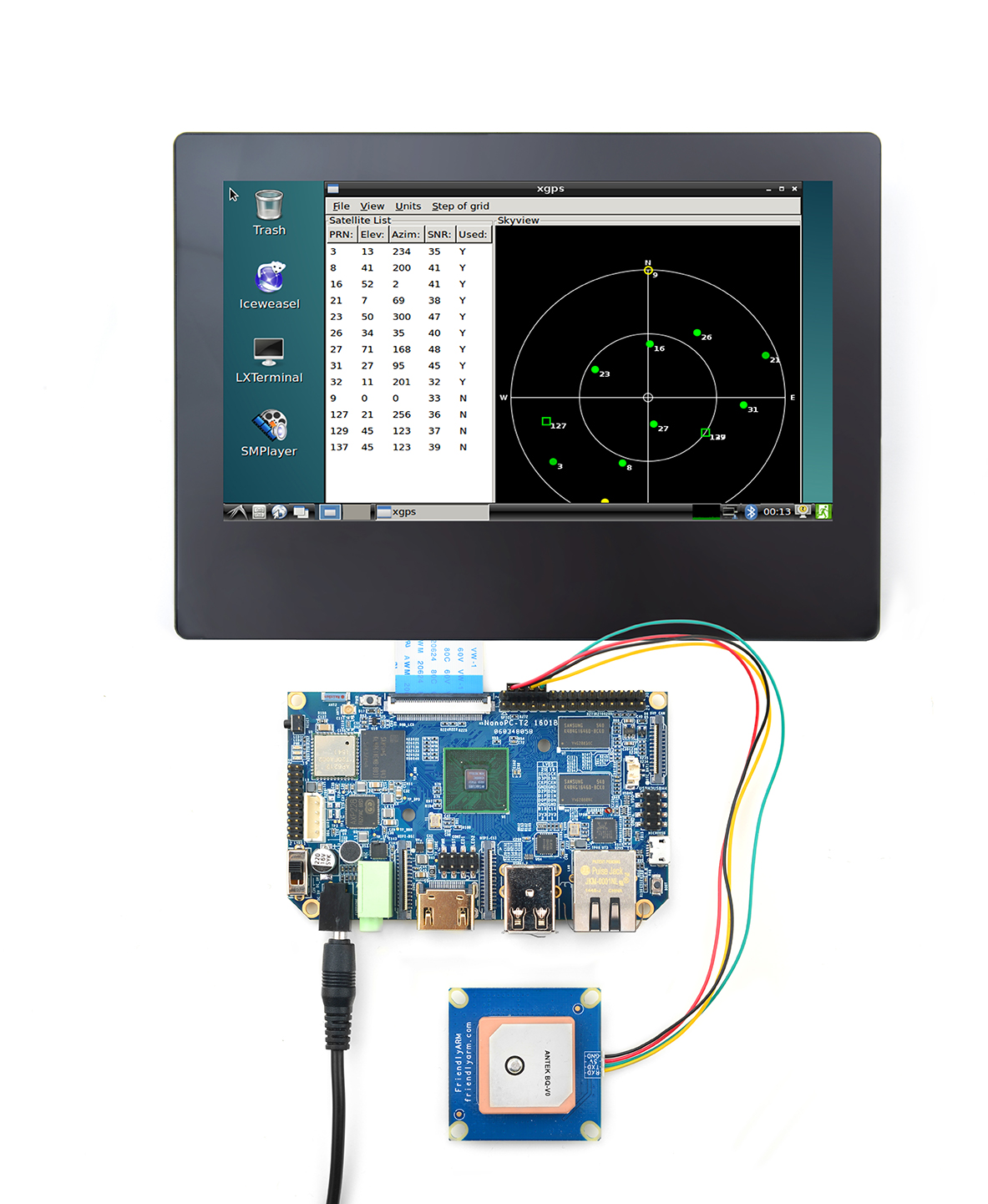
Connection Details:
| Matrix-GPS | NanoPC-T2 |
| RXD | Pin11 |
| TXD | Pin12 |
| 5V | Pin29 |
| GND | Pin30 |
5.5 Connect NanoPC-T2 to FriendlyARM LCD Modules
- Android
Here are the LCDs that are supported under Android:S430, S700/S701, S702, HD700, HD702, HD101 and X710 all of which are LCDs with capacitive touch.
- Debian
Here are the LCDs that are supported under Debian:S430, S700/S701, S702, HD700, HD702, HD101 and X710 all of which are LCDs with capacitive touch;
W35B, H43, P43, S70D and Matrix 2.8" SPI Key TFT LCD all of which are LCDs with resistive touch
All these LCD's tech details can be obtained on our wiki site:LCDModules
6 Access Hardware under Android
FriendlyElec developed a library called “libfriendlyarm-hardware.so”, for android developer to access the hardware resources on the development board in their android apps, the library is based on Android NDK.
Accessible Modules:
- Serial Port
- PWM
- EEPROM
- ADC
- LED
- LCD 1602 (I2C)
- OLED (SPI)
Interfaces & Ports:
- GPIO
- Serial Port
- I2C
- SPI
Refer to the following url for details:
- Homepage: http://wiki.friendlyarm.com/wiki/index.php/Android_Hardware_Access
- Examples: https://github.com/friendlyarm/AndroidHardwareAccess
- Guide to API in Chinese: https://github.com/friendlyarm/AndroidHardwareAccess/blob/master/友善电子Android硬件开发指南.pdf
7 More OS Support
7.1 Ubuntu-Mate
Ubuntu-Mate is a Ubuntu variant and its GUI is Mate-desktop. You can log in via SSH when you connect the NanoPC-T2 to an LCD or HDMI
FriendlyARM doesn't provide technical support for it
- Go to this link download link to download the image files
- Uncompress it and flash the image file to a TF card with win32diskimager under Windows
- After it is done you can boot your NanoPC-T2 with this card
- Login name: "root" or "fa", Password: fa
7.2 Kali
- Go to this link [3] to download the image files;
- Prepare an 8G High Speed MicroSD card, insert it to a Linux host and do "sudo fdisk -l" to check its device name, i.e. "/dev/sd*".
- Copy the image files to the card by running the following commands as root:
xzcat kali-2.0-nanopi2.img.xz | dd of=<YOURDEVICE> bs=1m
- After it is done you can boot your NanoPC-T2 with this card.
Note: this is offered by Kali and FriendlyARM doesn't provide technical support for it.
7.3 DietPi_NanoPC T2-armv7-(Jessie)
DietPi is a lightweight Debian Jessie OS with images starting at 400MB. It is highly optimized for minimal CPU and RAM resource usage, ensuring your SBC always runs at its maximum potential.
This image is for users' reference and FriendlyElec doesn't provide technical support for it.
Installation Steps:
- Download image file DietPi_NanoPC T2-armv7-(Jessie) at DietPi_NanoPC T2-armv7-(Jessie)
- Extract the image file and flash it to a MicroSD card with the win32diskimager utility under Windows.
- After installation is done insert this MicroSD card to a NanoPC T2, power on and you will be able to play with DietPi_NanoPC T2-armv7-(Jessie).
Username:root; Password:dietpi
7.4 Deepin15 ARM
- Go to this link [4] to download the image files
- Uncompress the file and you will get a 16g.img file which is the image file for MicroSD card.
tar -xf deepin15_nanopi2_armhf_16g.tar.gz
- Prepare an 16G High Speed SD card, insert it into a Linux host and do "sudo fdisk -l" to check its device name, i.e. "/dev/sd*"
- Flash the image files to the card by running the following command as root(in our case our card was recognized as "/dev/sdc"):
sudo dd if=16g.img of=/dev/sdc
This process takes a while which can be up to one hour
- After it is done you can boot your NanoPC-T2 with this card
Notes:
1. The password for login name "deepin" is "deepin". The password for login name "root" is "admin".
2. The initial booting of Deepin15 takes a relative long time for it generates some configuration files.
3. If WiFi is activated in your system booting might take longer. In this case wait for the sound and wifi icons on the right bottom of the GUI to appear before you start any action.
ARM code: http://packages.deepin.com/armhf/ NanoPC-T2 Image: http://cdimage.deepin.com/armhf/15/beta1.0/ NanoPC-T2 Image Installation Instruction; http://bbs.deepin.org/forum.php?mod=viewthread&tid=36670 Forum for Migrating Deepin15 to ARM: http://bbs.deepin.org/
Note: this is offered by the Deepin15 team and FriendlyARM doesn't provide technical support for it.
7.5 Android-Remixos
Go to this link [5] to download the image files;
- Untar the image ball:
tar -xf nanopi2-android-remixos-sd4g.tar
- Use the win32diskimager utility to flash the image to an SD card.
It supports HDMI and LCD output and works with all existing FriendlyARM 4418 boards.
Note: this is offered by Remix team and FriendlyARM doesn't provide technical support for it.
7.6 OpenMediaVault
A very warm hearted member: Volker Theile from openmediavault got OMV3 running on our NanoPC-T2. Here is a reference link:
Here is a how-to link: http://forum.openmediavault.org/index.php/Thread/15882-Install-OMV3-on-FriendlyArm-NanoPC-T2-4418/
8 Source Code and Image Files Download Links
9 Resources
- 《创客秘籍》Hacker's Book in Chinese by FriendlyARM
- 《创客秘籍-02》Hacker's Book-02 in Chinese by FriendlyARM
- 《创客秘籍-03》Hacker's Book-03 in Chinese by FriendlyARM
- SEC_Users_Manual_S5P4418_Users_Manual_Preliminary[8]
- AXP228_Users_Manual AXP228_V1.1_20130106
- eMMC eMMC5.0_1xnm_based_e_MMC
- Schematic(NanoPC-T2_1601B_Schematic.pdf)
- PCB Dimension(NanoPC-T2-Dimensions(dxf))
- Component-Position-Diagram([9])
- Matrix Modules & Wiki Sites:
- Button
- LED
- A/D Converter
- Relay
- 3-Axis Digital Accelerometer
- 3-Axis Digital Compass
- Temperature Sensor
- Temperature & Humidity Sensor
- Buzzer
- Joystick
- I2C(PCF8574)+LCD1602
- Sound Sensor
- Ultrasonic Ranger
- GPS
- Matrix - Compact Kit
- Fire Sensor
- CAM500A Camera
- BAll Rolling Switch
- 2'8 SPI Key TFT 2.8" SPI LCD
- IR Counter
- IR Receiver
- L298N Motor Driver
- MQ-2 Gas Sensor
- MQ-3 Gas Sensor
- One_Touch_Sensor
- _Photoresistor
- _Potentiometer
- Pressure & Temperature Sensor
- RGB LED
- RTC
- Rotary Encoder
- Soil Moisture Sensor
- Thermistor
- USB WiFi
- Water Sensor
10 Tech Support
If you have any further questions please visit our forum[10] and post a message or email us at techsupport@friendlyarm.com. We will endeavor to get back to you as soon as possible.
